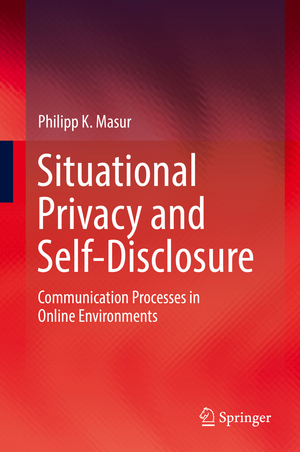Situational Privacy and Self-Disclosure: Communication Processes in Online Environments
Autor Philipp K. Masuren Limba Engleză Hardback – 12 iul 2018
Using both a theoretical argumentation and an empirical investigation, this book rationalizes the view that in order to understand people’s privacy perceptions and behaviors, a situational perspective needs to be adopted.
To this end, the book is divided into three parts. Part I advances the theory of situational privacy and self-disclosure by discussing impacts of new information and communication technologies on traditional theories of privacy and self-disclosure. Based on five basic suppositions, it describes three major processes of the theory: pre-situational privacy regulations processes, situational privacy perception and self-disclosure processes, and post-situational evaluation processes. Next, Part II presents the application of the theory to smartphone-based communication. It first analyses how people choose certain communication environments on their smartphones, how they manipulate them, and how these external factors affect self-disclosure within these environments. It then details a multi-method study conducted to test the derived assumptions and discusses the obtained results. Part III reflects on the overall implications of the theory, summarizes the major findings and lastly considers possible extensions and perspectives on future research.
Intended mainly for researchers in privacy and communication studies, the book offers privacy scholars a systematic review of both classic and contemporary theories of privacy and self-disclosure. At the same time, communication scholars benefit from an additional methodological discussion of the mobile experience sampling method, which provides an invaluable approach to measuring situational communication processes.
| Toate formatele și edițiile | Preț | Express |
|---|---|---|
| Paperback (1) | 645.96 lei 6-8 săpt. | |
| Springer International Publishing – 10 ian 2019 | 645.96 lei 6-8 săpt. | |
| Hardback (1) | 652.31 lei 6-8 săpt. | |
| Springer International Publishing – 12 iul 2018 | 652.31 lei 6-8 săpt. |
Preț: 652.31 lei
Preț vechi: 767.42 lei
-15% Nou
Puncte Express: 978
Preț estimativ în valută:
124.83€ • 135.55$ • 104.86£
124.83€ • 135.55$ • 104.86£
Carte tipărită la comandă
Livrare economică 23 aprilie-07 mai
Preluare comenzi: 021 569.72.76
Specificații
ISBN-13: 9783319788838
ISBN-10: 3319788833
Pagini: 424
Ilustrații: XIII, 394 p. 30 illus.
Dimensiuni: 155 x 235 mm
Greutate: 0.75 kg
Ediția:1st ed. 2019
Editura: Springer International Publishing
Colecția Springer
Locul publicării:Cham, Switzerland
ISBN-10: 3319788833
Pagini: 424
Ilustrații: XIII, 394 p. 30 illus.
Dimensiuni: 155 x 235 mm
Greutate: 0.75 kg
Ediția:1st ed. 2019
Editura: Springer International Publishing
Colecția Springer
Locul publicării:Cham, Switzerland
Cuprins
1. Introduction.- 2. New Media Environments and Their Threats.- 3. Theories of Privacy.- 4. Theories of Self-Disclosure.- 5. Connecting Privacy and Self-Disclosure.- 6. Privacy and Self-Disclosure in the Age of Information.- 7. The Theory of Situational Privacy and Self-Disclosure.- 8. Applying the Theory to Smartphone-Based Communication.- 9. Methods.- 10. Results.- 11. Discussion.- 12. Overall Discussion.- 13. Overall Conclusion and Outlook.- A. Additional Tables and Figures to Chapter 9.- B. Additional Tables and Figures to Chapter 10.- References.
Notă biografică
Philipp K. Masur is a research assistant at the Department of Media Psychology at the School of Communication of the University of Hohenheim (Stuttgart, Germany). His research aims to provide insights into computer-mediated communication, and he is especially interested in the psychological experience of privacy in online environments.
Textul de pe ultima copertă
Using both a theoretical argumentation and an empirical investigation, this book rationalizes the view that in order to understand people’s privacy perceptions and behaviors, a situational perspective needs to be adopted.
To this end, the book is divided into three parts. Part I advances the theory of situational privacy and self-disclosure by discussing impacts of new information and communication technologies on traditional theories of privacy and self-disclosure. Based on five basic suppositions, it describes three major processes of the theory: pre-situational privacy regulations processes, situational privacy perception and self-disclosure processes, and post-situational evaluation processes. Next, Part II presents the application of the theory to smartphone-based communication. It first analyses how people choose certain communication environments on their smartphones, how they manipulate them, and how these external factors affect self-disclosure within theseenvironments. It then details a multi-method study conducted to test the derived assumptions and discusses the obtained results. Part III reflects on the overall implications of the theory, summarizes the major findings and lastly considers possible extensions and perspectives on future research.
Intended mainly for researchers in privacy and communication studies, the book offers privacy scholars a systematic review of both classic and contemporary theories of privacy and self-disclosure. At the same time, communication scholars benefit from an additional methodological discussion of the mobile experience sampling method, which provides an invaluable approach to measuring situational communication processes.
Caracteristici
Synthesizes independently developed theories of privacy and self-disclosure into one comprehensive theoretical rationale Provides an abstract framework that allows the antecedents of self-disclosure to be identified and systematized into personal and environmental as well as non-situational and situational factors Empirically investigates the theory in the context of smartphone-based communication
